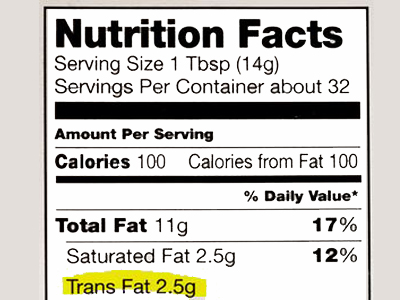Why Are Trans Fats Bad? Even the FDA Agrees They are Worse Than Expected
 Knowledge of the evils of trans fats has been accumulating for years, but it wasn’t until recently that the slow-acting FDA finally admitted that industrial produced trans fats may not be safe for human consumption. The FDA is considering removing partially hydrogenated oils from the “generally recognized as safe” (GRAS) list, a move that would essentially end up eliminated artificially created trans fat from the food supply.[1]
Knowledge of the evils of trans fats has been accumulating for years, but it wasn’t until recently that the slow-acting FDA finally admitted that industrial produced trans fats may not be safe for human consumption. The FDA is considering removing partially hydrogenated oils from the “generally recognized as safe” (GRAS) list, a move that would essentially end up eliminated artificially created trans fat from the food supply.[1]
Knowing how slowly the FDA typically acts, how behind-the-times they are on matters of nutrition, and how easily swayed they can be by industry lobbying, the fact that they are making this move against trans-fats is remarkable indeed. Essentially, if the FDA is saying trans fats are unsafe and worse than we thought, they must be really bad.
And indeed they are! “Trans fat has been linked to an increased risk of coronary heart disease, in which plaque builds up inside the arteries and may cause a heart attack,” says the FDA in a recent article they released for consumers explaining their new position.[2] Ridding our food supply of trans fats is expected to literally prevent thousands of heart disease-related deaths and keep tens of thousands of heart attack patients out of the hospital each year.[2]
Why are trans fats bad for your health?
What the FDA doesn’t mention, however, is that trans fats not only increase your risk of heart disease, they up your risk of a number of other dreaded diseases as well. Studies have found that higher intake of trans fats is directly related to higher rates of:
- Diabetes[3]
- High blood pressure[4]
- Insulin resistance[3]
- Metabolic syndrome[3]
- Non-alcoholic fatty liver disease
- Strokes[5]
- Depression[6]
- Aggression/irritability[7]
- Inflammation[8]
- Cancer[9,10]
- Cognitive decline[11]
- Infertility
- Death from all causes[12]
What is trans fat?
Trans fat is in the partially hydrogenated oils used to make many popular processed foods found at the supermarket. From breads and other baked goods to snacks and frozen foods, trans fats have been widely used as ingredients since the 1950s to increase the shelf-life and flavor stability of foods.
Under the current labeling laws, foods are allowed to claims “0 grams trans fat,” as long as they have less than 0.5 grams of trans fat per serving. However, many people eat more than one serving of trans fat-laden foods, and the grams add up quickly and easily, especially if you tend to frequently eat certain brands or types of food products. Approximately 5 grams of trans fat per day (an amount easily achieved) increases the risk of cardiovascular diseases by about 23%.[13]
With the research on trans fat continuing to pour in, it’s likely that in the coming years scientists will discover even more ways these evil industrially-produced fats damage your health. But the evidence is already so overwhelming that you should not wait even a moment longer to completely eliminate added trans fats from your diet. In part 2 of this article, we’ll go more into how to identify hidden sources of trans fat because it is not always as simple as looking for “partially hydrogenated oil” in the ingredients list on the label.
[1] FDA Federal Register. Trans-Fats Notice. 2013, Nov.8.
[2] FDA Consumer Update. 2013, Nov 7.
[3] Nature Rev Endocrin. 2009 June;5:335-344.
[4] Hypertension. 2010 Oct;56(4):598-604.
[5] Ann Neurol. 2012 Nov;72(5):704-15.
[7] PLoS One. 2012;7(3):e32175.
[8] J Lipid Res. 2011 Oct;52(10):1821-8.
[9] Nutr Cancer. 2012;64(8):1131-42.
[10] J Nutr. 2013 May;143(5):672-81.
[11] Neurology. 2012 Jan 24;78(4):241-9.


 Ask the EN Experts March 2025
Ask the EN Experts March 2025  Vegan Diet Better Than Omnivore Diet for Cardiovascular Health
Vegan Diet Better Than Omnivore Diet for Cardiovascular Health 